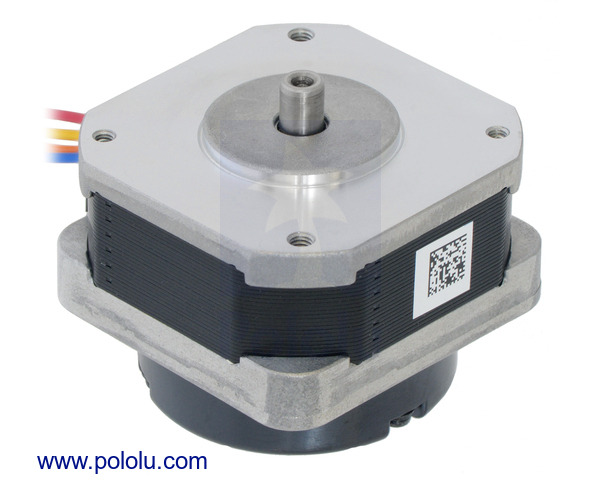

This is a merged information page for Item #2279.
View normal product page.
Pololu item #:
2279
Brand:
Sanyo Denki

This NEMA 17-size pancake bipolar stepping motor from Sanyo features an integrated high-resolution (1000 P/R) quadrature encoder that allows for 4000 counts per revolution of the output shaft when counting both edges of both channels. The stepper motor itself has a 1.8° step angle (200 steps/revolution) and each phase draws 1 A at 5.4 V, allowing for a holding torque of 1.9 kg-cm (26 oz-in).
 Compare all products in Stepper Motors.
Compare all products in Stepper Motors.
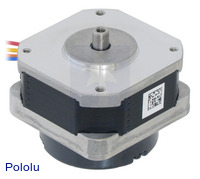 |
Sanyo Pancake Stepper Motor with Encoder: Bipolar, 200 Steps/Rev, 42×31.5mm, 5.4V, 1 A/Phase, 4000 CPR (SS2422-50XE100). |
|---|
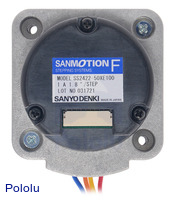 |
Bottom view of the 42×31.5mm Sanyo pancake stepper motor with encoder. |
|---|
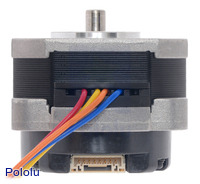 |
Side view of the SS2422-50XE100 42×31.5mm Sanyo pancake stepper motor. |
|---|
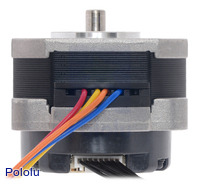 |
Side view of the 42×31.5mm Sanyo pancake stepper motor with included encoder cable plugged in. |
|---|
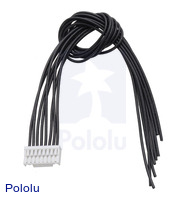 |
15 cm (6″) encoder cable included with the Sanyo pancake stepper motors with encoders. |
|---|
 |
The included encoder cable is terminated on one end by a JST GHR-08V-S connector that matches the encoder connector on the stepper motor (the other end is unterminated). |
|---|
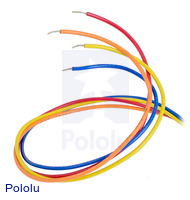 |
Bipolar stepper motor wires are terminated with bare leads. |
|---|
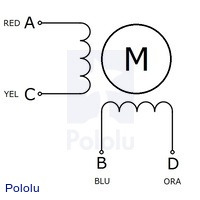 |
Sanyo bipolar stepper motor wiring diagram. |
|---|
 |
Dimensions (in mm) of the SS2422-50XE100 42×31.5mm Sanyo pancake stepper motor with encoder. |
|---|
 |
Specifications for the quadrature encoder integrated into the Sanyo SS242x-50XE100 stepper motors with encoders. |
|---|
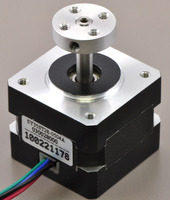 |
5mm Pololu universal aluminum mounting hub on a stepper motor with a 5mm-diameter output shaft. |
|---|
 |
Bipolar stepper motor wires are terminated with bare leads. |
|---|
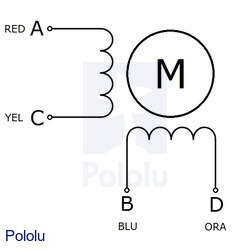 |
Sanyo bipolar stepper motor wiring diagram. |
|---|
This NEMA 17-size pancake bipolar stepping motor from Sanyo features an integrated high-resolution (1000 P/R) quadrature encoder that allows for 4000 counts per revolution of the output shaft when counting both edges of both channels. The stepper motor itself has a 1.8° step angle (200 steps/revolution) and each phase draws 1 A at 5.4 V, allowing for a holding torque of 1.9 kg-cm (26 oz-in). The motor has four color-coded wires terminated with bare leads: red and yellow connect to one coil; orange and blue connect to the other. It can be controlled by a pair of suitable H-bridges (one for each coil), but we recommend using a bipolar stepper motor driver or one of our Tic Stepper Motor Controllers. In particular, the Tics make control easy because they support six different interfaces (USB, TTL serial, I²C, RC, analog voltages, and quadrature encoder) and are configurable over USB with our free configuration utility.
Our 5 mm universal mounting hub can be used to mount objects on the stepper motor’s 5 mm-diameter output shaft, and our NEMA 17 aluminum bracket offers a variety of options for mounting this stepper motor in your project.
This stepper motor is also available without an encoder.
More specifications are available in the SS242x stepper motor datasheet (385k pdf) and the product-specific SS2422-50XE100 datasheet (567k pdf).
 |
Dimensions (in mm) of the SS2422-50XE100 42×31.5mm Sanyo pancake stepper motor with encoder. |
|---|
We also carry a thinner version of this stepper motor with identical dimensions except for the height. The pictures below show this stepper motor on the left and the thinner version on the right:
|
|
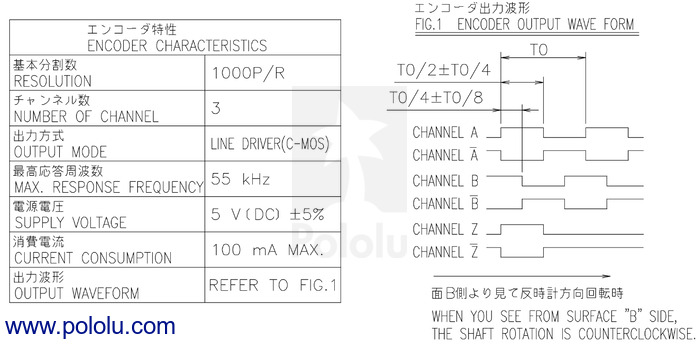 |
The integrated quadrature encoder operates from 5 V and has a resolution of 1000 P/R, which allows for 4000 counts per revolution (CPR) of the output shaft when counting both edges (i.e. rising and falling) of both channels (i.e. A and B). In addition to the A and B channel outputs, the encoder has a home channel, Z, that pulses once per revolution and can be used for absolute positioning. The encoder also has outputs for the inverse of A, B, and Z. A 15 cm (6″) encoder cable is included.
|
|
|
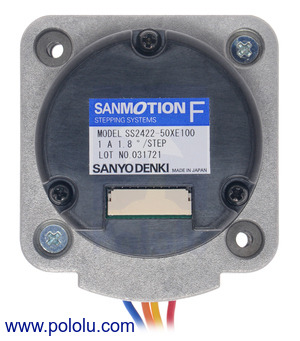 |
Bottom view of the 42×31.5mm Sanyo pancake stepper motor with encoder. |
|---|
Stepper motors are generally used in a variety of applications where precise position control is desirable and the cost or complexity of a feedback control system is unwarranted. Here are a few applications where stepper motors are often found:
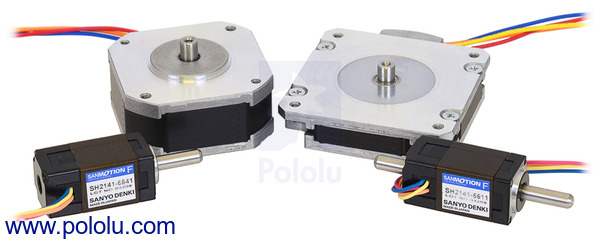 |
Sanyo stepper motors; from left to right: 14mm single shaft, 42×18.6mm, 50×11mm, 14mm double shaft |
|---|
Note: Sanyo Denki calls this product the “SANMOTION F2 STEPPING SYSTEMS TYPE SS2422-50XE100”.
| Size: |
42 mm square × 31.5 mm (NEMA 17)1 |
|---|---|
| NEMA size: | 17 |
| Weight: | 165 g |
| Shaft diameter: | 5 mm |
| Current rating: | 1000 mA2 |
|---|---|
| Voltage rating: | 5.4 V |
| Model: | SS2422-50XE100 |
| Holding torque: | 26.33 oz·in |
| Steps per revolution: | 200 |
| Resistance: | 5.4 Ohm2 |
| Inductance per phase: | 2.9 mH |
| Number of leads: | 4 |
| Lead length: | 30 cm3 |
| Encoders?: | Y |
| Encoder resolution: | 4000 CPR4 |
Yes. To avoid damaging your stepper motor, you want to avoid exceeding the rated current, which is 600 mA in this instance. All of our stepper motor drivers let you limit the maximum current, so as long as you set the limit below the rated current, you will be within spec for your motor, even if the voltage exceeds the rated voltage. The voltage rating is just the voltage at which each coil draws the rated current, so the coils of your stepper motor will draw 600 mA at 3.9 V. By using a higher voltage along with active current limiting, the current is able to ramp up faster, which lets you achieve higher step rates than you could using the rated voltage.
If you do want to use a lower motor supply voltage for other reasons, consider using our DRV8834 or STSPIN-220 low-voltage stepper motor drivers.
We are now offering two new NEMA 17-size pancake bipolar stepper motors from Sanyo, each featuring an integrated high-resolution quadrature encoder...